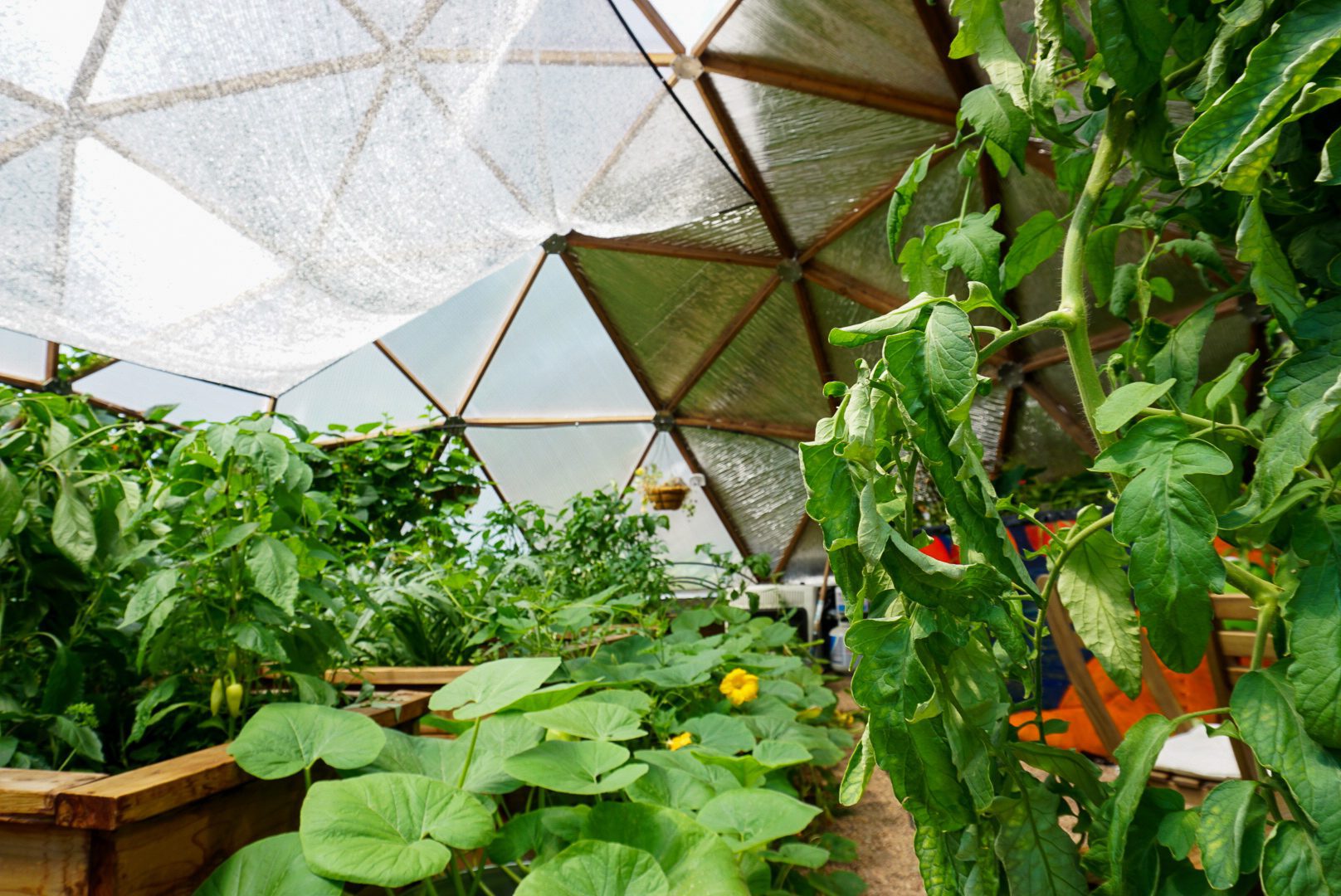
This post may contain affiliate links.
There are many types of squash, but we will talk about growing pumpkins in your dome to finish our Three Sisters series. Pumpkin is from the Cucubitaceae family and is a winter squash. In the Three Sisters method of gardening Native Americans planted squash as one of the benefits is the ground cover the leaves provide, so pick the squash you like best!

Squash originated in the Americas; from North America to South America, there were about 20 species of squash growing wild. Squash was first recorded in Europe in 1591, although the earliest domestication of squash was in Mexico 8,000 years ago. We think of squash, particularly pumpkins, as part of our Thanksgiving tradition. Some variety of squash was part of the three-day feast in the Plymouth Colony, but they did not prepare their squash as pumpkin pie! Due to the fact that squash is a gourd with hard-skin, the Colonials grew pumpkins as containers for their food.
Health Benefits of the Great Pumpkin
Pumpkin is 80-90% water and packed with antioxidants, especially beta-carotene, which gives it that lovely orange color. Our bodies turn beta-carotene into vitamin A for healthy skin and eyes and builds our immune system. nother benefit is the high level of potassium, which lowers blood pressure. (Maybe that is why we eat it at our big Thanksgiving feasts!) As our bodies ages, potassium levels drop. The drop in potassium levels is connected to hearing loss, so eating pumpkins can help protect your hearing. And remember the seeds! Pumpkin seeds have nutrients like zinc, magnesium, protein, copper, manganese, vitamin C, and fiber.
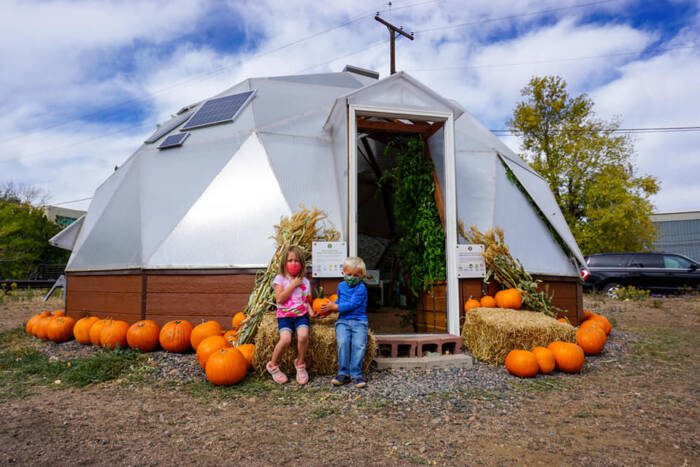
Growing Pumpkins
Growing pumpkins in your dome takes space, so plan carefully. Even a smaller variety of pumpkin requires 15-36 square feet, and if you are using the Three Sisters approach and plant in a 3×5 foot space, plant a few pumpkin seeds in between and around the corn and pole beans.
Alternatively, we grew pumpkins outside our dome this year after the soil was between 65-95 degrees F. Remember that pumpkins do not tolerate cold or frost! If you grow corn outside, add pumpkin seeds around the corn block, and the corn will provide some shade for your dome.
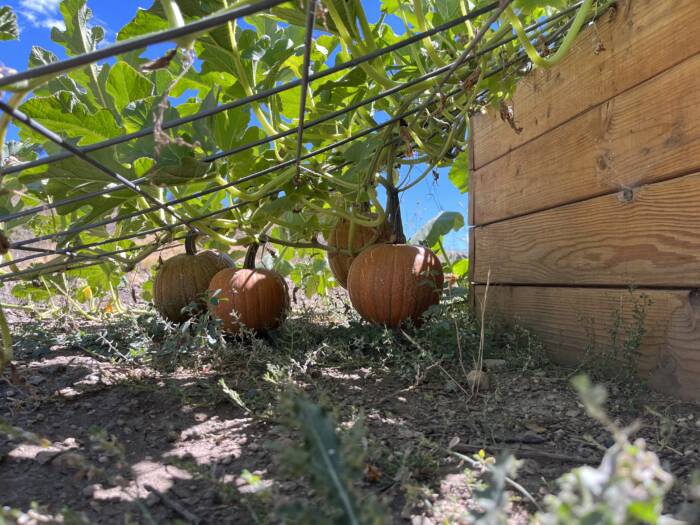
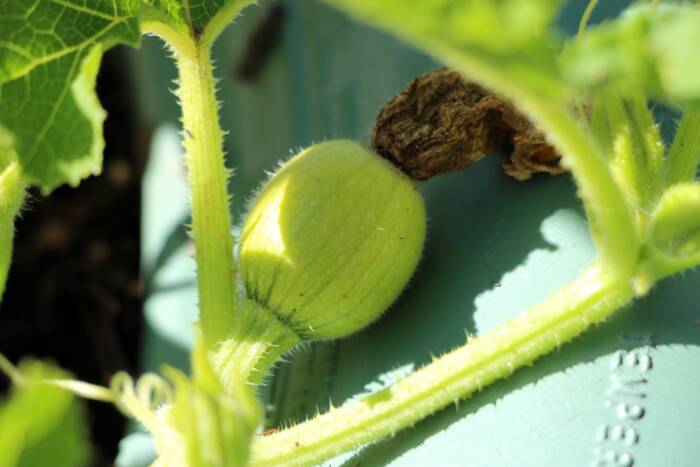

Plant pumpkin seeds one inch deep and 6 to 12 inches apart. Thin pumpkins when they reach 2 to 3 inches tall so they are 18 to 36 inches apart. Some gardeners trellis pumpkins or grow a companion plants such as pole beans between pumpkin seedlings. Use a strong trellis for pumpkins since they need good support. You can repurpose old stockings or use netting to bear the weight of the pumpkins as they grow.
Male blossoms will arrive a week or two before female blooms, but there is a only a short period of time to pollinate them. Female blossoms are open for just a few hours, so if you want pumpkins, to be a blossom stalker! If you are growing pumpkins inside your dome and do not have many pollinators, you must hand pollinate them.

Caring For Your Pumpkins
Pumpkins need one inch of water per week, but be careful not to water the leaves as this invites diseases such as powdery mildew. Give pumpkins a deep soaking, especially if the weather is hot. Weed pumpkins carefully as their roots are tender and shallow. Be careful not to damage the vine as this affects the quality of your pumpkin (another reason to support their weight if you grow them on a trellis).
Pumpkins are heavy feeders, so fertilize them throughout their growing season. Add aged manure or compost mixed with water. Another suggestion is once they are at least one foot tall, just before the vines begin to run, fertilize them regularly with a high-nitrogen formula. And before the blooming period, switch to a high-phosphorus fertilizer.
After you have a few pumpkins growing on a vine, you can pinch the fuzzy end of the vine to encourage the growth to go into the pumpkins and save space since the vine will stop growing. It is helpful to put a piece of board or stone under each pumpkin to prevent it from rotting on the soil.
Growing Pumpkins Fun Facts
- The world record for the biggest pumpkin is 2,624 pounds; that’s almost the size of Cinderella’s carriage! There are also small varieties that weigh less than 4 pounds, great for small gardens.
- The word squash is from an Algonquin word “askutasquash” and means “eaten raw” or “uncooked”.
- Winter squash is harvested in the fall, but is called winter squash because it can be stored through the winter.
- Pilgrims made pie by hollowing out a pumpkin, then filling it with apples, sugar, spices and milk. The stem went back on the top and the pie was baked in the pumpkin “shell”.
- Did you know that the Colonials in North America made pumpkin beer or ale? Cheers!
Growing Pumpkin Companion Plants
It’s time to share about companion planting with pumpkins! The Three Sisters: pole beans, corn and squash, are a great example of companion planting. As we mentioned before the pole beans climb the corn, which eliminates the need for a trellis and they fix nitrogen in the soil, which benefits all three plants. The pumpkin/squash leaves act as mulch, shading the soil and preventing weeds. Plus critters don’t care for the prickly leaves so if your Three Sisters garden is outside, the pumpkin leaves act as a deterrent.
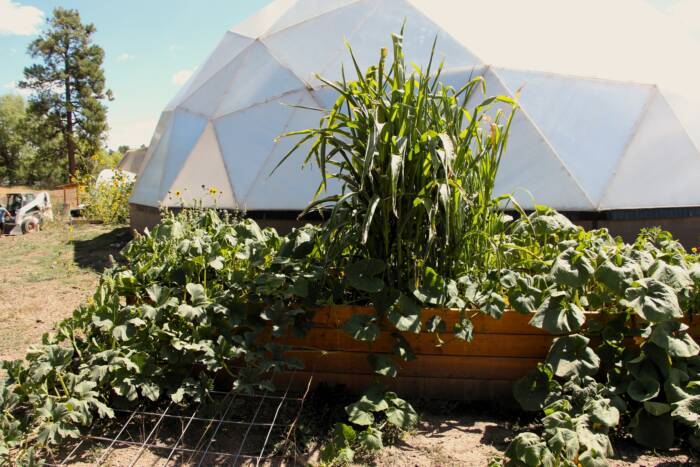
Native American squash was different and yellow summer crookneck squash, zucchini or hubbard squash are probably the closest types, but we are using pumpkins for our squash this season. The Three Sisters method has a fourth sister that isn’t talked about much and that is…sunflowers! Sunflowers can support the beans, the seeds lure birds away from the corn and attract pollinators!
Pumpkin also does well with herbs like oregano, chives, marjoram, tansy, hyssop and chamomile. Radishes are tasty to flea beetles so are a good trap crop. Nasturtiums are beautiful, delicious and attract beneficial insects into your dome. Companion planting is also about what not to plant. For pumpkins, avoid planting potatoes and brassicas. Visit the Farmers’ Almanac Companion Planting Guide to learn more.
How to Harvest Pumpkins
Pumpkins take between 80-120 days to mature and should only be picked once fully mature. Do not rely on their size to determine maturity though. When they mature the leaves of the plant will die back and the skin will be hard. The skin will also turn a deeper, solid color and the stem will harden. You can thump the pumpkin with your finger to test the hardness and listen for a hollow sound. Another way to check is to use your fingernail and try to puncture the skin. If you can’t puncture it, it’s ripe. Now what to do with your pumpkin! There are many great recipes and Pumpkin Squash Risotto is one of our favorites!
It’s best to cut the pumpkin from the vine with a knife or pruners; do not tear it. Be sure to leave at least 3 to 4 inches of the stem to lengthen the storage time. Although the skin is hard, pumpkins can still bruise so handle them gently and do not carry pumpkins by the stem.
If you want to harden the skin as well as increase the flavor, cure your pumpkins in a sunny spot for around 10 days. This is best done in an area that is 80-85 degrees with the same amount of humidity…maybe in your dome? After you cure them, store them in a cool, dry area such as a cellar. They can be stored that way for 2-3 months if the temperature is 50-55 degrees. You can save pumpkin seeds for up to 6 years if they are saved properly. Now go enjoy something pumpkin spice-flavored! Happy gardening!
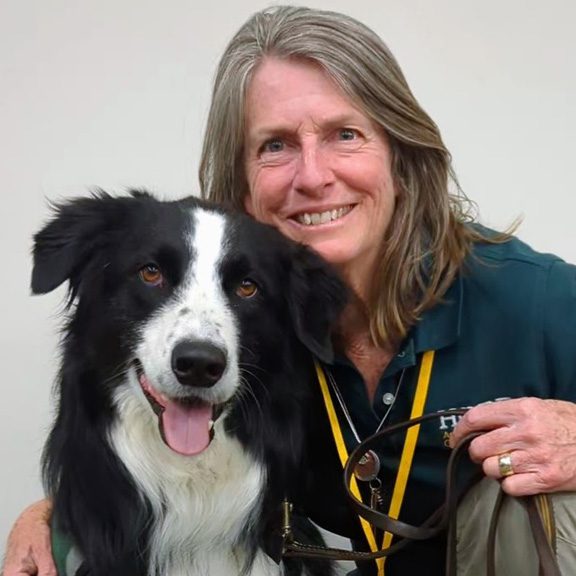
2 Comments
My pumpkins got hit by frost. I have one thats about 1.5lb and one thats just a few ounces. Woykd it be wise to put them in a greenhouse or is it too late for them to survive?
You can try putting them in the greenhouse, but they should have been ready to harvest by now. When did you plant them and what is your weather like or what zone are you in? You could try using a frost blanket, but it’s probably better to bring thing into the greenhouse. I have a small pumpkin that I harvested and brought into my house. It’s been ripening in a west facing window and is now fully ripe. I’m going to cut into it this week.